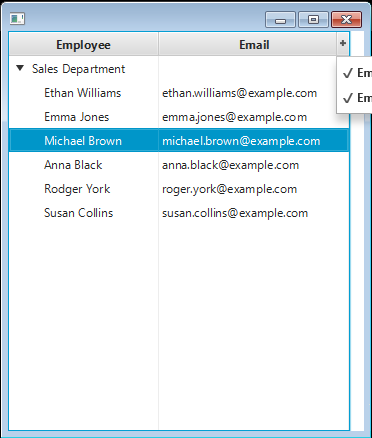JavaFX教程 – JavaFX树表视图
JavaFX TreeTableView在表列中渲染数据的层次结构。
TreeTableView组件组合了TreeView和TableView控件。
import javafx.application.Application;
import javafx.beans.property.ReadOnlyStringWrapper;
import javafx.scene.Group;
import javafx.scene.Scene;
import javafx.scene.control.TreeTableColumn;
import javafx.scene.control.TreeTableColumn.CellDataFeatures;
import javafx.scene.control.TreeItem;
import javafx.scene.control.TreeTableView;
import javafx.stage.Stage;
public class Main extends Application {
public static void main(String[] args) {
Application.launch(args);
}
@Override
public void start(Stage stage) {
final Scene scene = new Scene(new Group(), 200, 400);
Group sceneRoot = (Group) scene.getRoot();
TreeItem<String> childNode1 = new TreeItem<>("Node 1");
TreeItem<String> childNode2 = new TreeItem<>("Node 2");
TreeItem<String> childNode3 = new TreeItem<>("Node 3");
TreeItem<String> root = new TreeItem<>("Root");
root.setExpanded(true);
root.getChildren().setAll(childNode1, childNode2, childNode3);
TreeTableColumn<String, String> column = new TreeTableColumn<>("Column");
column.setPrefWidth(150);
column.setCellValueFactory((CellDataFeatures<String, String> p) -> new ReadOnlyStringWrapper(
p.getValue().getValue()));
TreeTableView<String> treeTableView = new TreeTableView<>(root);
treeTableView.getColumns().add(column);
sceneRoot.getChildren().add(treeTableView);
stage.setScene(scene);
stage.show();
}
}
上面的代码生成以下结果。

添加几个列
/*
* Copyright (c) 2008, 2014, Oracle and/or its affiliates.
* All rights reserved. Use is subject to license terms.
*
* This file is available and licensed under the following license:
*
* Redistribution and use in source and binary forms, with or without
* modification, are permitted provided that the following conditions
* are met:
*
* - Redistributions of source code must retain the above copyright
* notice, this list of conditions and the following disclaimer.
* - Redistributions in binary form must reproduce the above copyright
* notice, this list of conditions and the following disclaimer in
* the documentation and/or other materials provided with the distribution.
* - Neither the name of Oracle nor the names of its
* contributors may be used to endorse or promote products derived
* from this software without specific prior written permission.
*
* THIS SOFTWARE IS PROVIDED BY THE COPYRIGHT HOLDERS AND CONTRIBUTORS
* "AS IS" AND ANY EXPRESS OR IMPLIED WARRANTIES, INCLUDING, BUT NOT
* LIMITED TO, THE IMPLIED WARRANTIES OF MERCHANTABILITY AND FITNESS FOR
* A PARTICULAR PURPOSE ARE DISCLAIMED. IN NO EVENT SHALL THE COPYRIGHT
* OWNER OR CONTRIBUTORS BE LIABLE FOR ANY DIRECT, INDIRECT, INCIDENTAL,
* SPECIAL, EXEMPLARY, OR CONSEQUENTIAL DAMAGES (INCLUDING, BUT NOT
* LIMITED TO, PROCUREMENT OF SUBSTITUTE GOODS OR SERVICES; LOSS OF USE,
* DATA, OR PROFITS; OR BUSINESS INTERRUPTION) HOWEVER CAUSED AND ON ANY
* THEORY OF LIABILITY, WHETHER IN CONTRACT, STRICT LIABILITY, OR TORT
* (INCLUDING NEGLIGENCE OR OTHERWISE) ARISING IN ANY WAY OUT OF THE USE
* OF THIS SOFTWARE, EVEN IF ADVISED OF THE POSSIBILITY OF SUCH DAMAGE.
*/
import java.util.Arrays;
import java.util.List;
import javafx.application.Application;
import javafx.beans.property.ReadOnlyStringWrapper;
import javafx.beans.property.SimpleStringProperty;
import javafx.scene.Group;
import javafx.scene.Scene;
import javafx.scene.control.TreeItem;
import javafx.scene.control.TreeTableColumn;
import javafx.scene.control.TreeTableView;
import javafx.stage.Stage;
public class Main extends Application {
List<Employee> employees = Arrays.<Employee> asList(new Employee(
"Ethan Williams", "ethan.williams@example.com"), new Employee(
"Emma Jones", "emma.jones@example.com"), new Employee("Michael Brown",
"michael.brown@example.com"), new Employee("Anna Black",
"anna.black@example.com"), new Employee("Rodger York",
"roger.york@example.com"), new Employee("Susan Collins",
"susan.collins@example.com"));
final TreeItem<Employee> root = new TreeItem<>(new Employee(
"Sales Department", ""));
public static void main(String[] args) {
Application.launch(Main.class, args);
}
@Override
public void start(Stage stage) {
root.setExpanded(true);
employees.stream().forEach((employee) -> {
root.getChildren().add(new TreeItem<>(employee));
});
Scene scene = new Scene(new Group(), 400, 400);
Group sceneRoot = (Group) scene.getRoot();
TreeTableColumn<Employee, String> empColumn = new TreeTableColumn<>(
"Employee");
empColumn.setPrefWidth(150);
empColumn
.setCellValueFactory((
TreeTableColumn.CellDataFeatures<Employee, String> param) -> new ReadOnlyStringWrapper(
param.getValue().getValue().getName()));
TreeTableColumn<Employee, String> emailColumn = new TreeTableColumn<>(
"Email");
emailColumn.setPrefWidth(190);
emailColumn
.setCellValueFactory((
TreeTableColumn.CellDataFeatures<Employee, String> param) -> new ReadOnlyStringWrapper(
param.getValue().getValue().getEmail()));
TreeTableView<Employee> treeTableView = new TreeTableView<>(root);
treeTableView.getColumns().setAll(empColumn, emailColumn);
sceneRoot.getChildren().add(treeTableView);
stage.setScene(scene);
stage.show();
}
public class Employee {
private SimpleStringProperty name;
private SimpleStringProperty email;
public SimpleStringProperty nameProperty() {
if (name == null) {
name = new SimpleStringProperty(this, "name");
}
return name;
}
public SimpleStringProperty emailProperty() {
if (email == null) {
email = new SimpleStringProperty(this, "email");
}
return email;
}
private Employee(String name, String email) {
this.name = new SimpleStringProperty(name);
this.email = new SimpleStringProperty(email);
}
public String getName() {
return name.get();
}
public void setName(String fName) {
name.set(fName);
}
public String getEmail() {
return email.get();
}
public void setEmail(String fName) {
email.set(fName);
}
}
}
上面的代码生成以下结果。

改变视觉外观
treeTableView.setTableMenuButtonVisible(true)启用表格菜单按钮,以便用户可以切换表列的可见性。 该方法将“+”按钮添加到表头。
/*
* Copyright (c) 2008, 2014, Oracle and/or its affiliates.
* All rights reserved. Use is subject to license terms.
*
* This file is available and licensed under the following license:
*
* Redistribution and use in source and binary forms, with or without
* modification, are permitted provided that the following conditions
* are met:
*
* - Redistributions of source code must retain the above copyright
* notice, this list of conditions and the following disclaimer.
* - Redistributions in binary form must reproduce the above copyright
* notice, this list of conditions and the following disclaimer in
* the documentation and/or other materials provided with the distribution.
* - Neither the name of Oracle nor the names of its
* contributors may be used to endorse or promote products derived
* from this software without specific prior written permission.
*
* THIS SOFTWARE IS PROVIDED BY THE COPYRIGHT HOLDERS AND CONTRIBUTORS
* "AS IS" AND ANY EXPRESS OR IMPLIED WARRANTIES, INCLUDING, BUT NOT
* LIMITED TO, THE IMPLIED WARRANTIES OF MERCHANTABILITY AND FITNESS FOR
* A PARTICULAR PURPOSE ARE DISCLAIMED. IN NO EVENT SHALL THE COPYRIGHT
* OWNER OR CONTRIBUTORS BE LIABLE FOR ANY DIRECT, INDIRECT, INCIDENTAL,
* SPECIAL, EXEMPLARY, OR CONSEQUENTIAL DAMAGES (INCLUDING, BUT NOT
* LIMITED TO, PROCUREMENT OF SUBSTITUTE GOODS OR SERVICES; LOSS OF USE,
* DATA, OR PROFITS; OR BUSINESS INTERRUPTION) HOWEVER CAUSED AND ON ANY
* THEORY OF LIABILITY, WHETHER IN CONTRACT, STRICT LIABILITY, OR TORT
* (INCLUDING NEGLIGENCE OR OTHERWISE) ARISING IN ANY WAY OUT OF THE USE
* OF THIS SOFTWARE, EVEN IF ADVISED OF THE POSSIBILITY OF SUCH DAMAGE.
*/
import java.util.Arrays;
import java.util.List;
import javafx.application.Application;
import javafx.beans.property.ReadOnlyStringWrapper;
import javafx.beans.property.SimpleStringProperty;
import javafx.scene.Group;
import javafx.scene.Scene;
import javafx.scene.control.TreeItem;
import javafx.scene.control.TreeTableColumn;
import javafx.scene.control.TreeTableView;
import javafx.stage.Stage;
public class Main extends Application {
List<Employee> employees = Arrays.<Employee> asList(new Employee(
"Ethan Williams", "ethan.williams@example.com"), new Employee(
"Emma Jones", "emma.jones@example.com"), new Employee("Michael Brown",
"michael.brown@example.com"), new Employee("Anna Black",
"anna.black@example.com"), new Employee("Rodger York",
"roger.york@example.com"), new Employee("Susan Collins",
"susan.collins@example.com"));
final TreeItem<Employee> root = new TreeItem<>(new Employee(
"Sales Department", ""));
public static void main(String[] args) {
Application.launch(Main.class, args);
}
@Override
public void start(Stage stage) {
root.setExpanded(true);
employees.stream().forEach((employee) -> {
root.getChildren().add(new TreeItem<>(employee));
});
Scene scene = new Scene(new Group(), 400, 400);
Group sceneRoot = (Group) scene.getRoot();
TreeTableColumn<Employee, String> empColumn = new TreeTableColumn<>(
"Employee");
empColumn.setPrefWidth(150);
empColumn
.setCellValueFactory((
TreeTableColumn.CellDataFeatures<Employee, String> param) -> new ReadOnlyStringWrapper(
param.getValue().getValue().getName()));
TreeTableColumn<Employee, String> emailColumn = new TreeTableColumn<>(
"Email");
emailColumn.setPrefWidth(190);
emailColumn
.setCellValueFactory((
TreeTableColumn.CellDataFeatures<Employee, String> param) -> new ReadOnlyStringWrapper(
param.getValue().getValue().getEmail()));
TreeTableView<Employee> treeTableView = new TreeTableView<>(root);
treeTableView.getColumns().setAll(empColumn, emailColumn);
treeTableView.setTableMenuButtonVisible(true);
sceneRoot.getChildren().add(treeTableView);
stage.setScene(scene);
stage.show();
}
public class Employee {
private SimpleStringProperty name;
private SimpleStringProperty email;
public SimpleStringProperty nameProperty() {
if (name == null) {
name = new SimpleStringProperty(this, "name");
}
return name;
}
public SimpleStringProperty emailProperty() {
if (email == null) {
email = new SimpleStringProperty(this, "email");
}
return email;
}
private Employee(String name, String email) {
this.name = new SimpleStringProperty(name);
this.email = new SimpleStringProperty(email);
}
public String getName() {
return name.get();
}
public void setName(String fName) {
name.set(fName);
}
public String getEmail() {
return email.get();
}
public void setEmail(String fName) {
email.set(fName);
}
}
}
我们可以通过使用TreeTableView类的setShowRoot方法显示或隐藏根树项目。
treeTableView.setShowRoot(false);
上面的代码生成以下结果。

分类
我们可以通过点击列标题对数据进行排序。
设置列的降序排序模式
aColumn.setSortType(TreeTableColumn.SortType.DESCENDING);
设置列的升序排序模式
aColumn.setSortType(TreeTableColumn.SortType.ASCENDING);
将排序模式应用于所有树项目
treeTableView.setSortMode(TreeSortMode.ALL_DESCENDANTS);
仅将排序模式应用于第一级节点
treeTableView.setSortMode(TreeSortMode.ONLY_FIRST_LEVEL);
管理选择模式
TreeTableView类的默认选择模型是SelectionMode.SINGLE。
要启用树项目和单元格的多重选择,请使用setSelectionModel和setCellSelectionEnabled方法的组合。
启用单元格的多重选择
treeTableView.getSelectionModel().setSelectionMode(SelectionMode.MULTIPLE); treeeTableView.getSelectionModel().setCellSelectionEnabled(true);

 国外主机测评 - 国外VPS,国外服务器,国外云服务器,测评及优惠码
国外主机测评 - 国外VPS,国外服务器,国外云服务器,测评及优惠码














